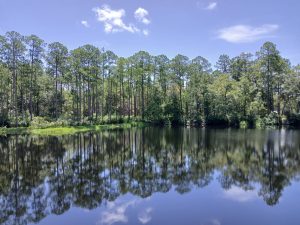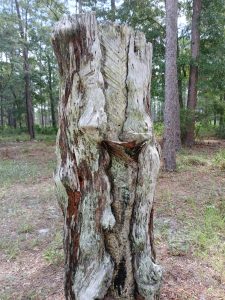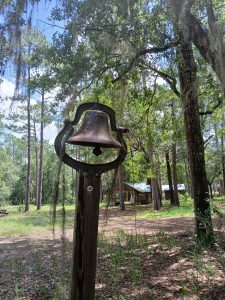The UF/IFAS Broward Extension Horticulture staff had the opportunity to attend a Florida Friendly Landscaping Program this past July 23rd and 24th at the Austin Cary Forest Campus Learning Center. This wonderful place of retreat and meditation outside the city of Gainesville hosts a variety of educational programs. While walking around the property it is possible to observe an important variety of native trees and shrubs, including loblolly pine trees.

Turpentine Still Trail
During a walk around the trails at the education center visitors can make several stops where they can learn about turpentine industry, that according to the kiosk descriptions, was very prominent in northeast Florida during the first decades of the past century (1900-1940ca.). Turpentine at that time was used for several purposes, including flavoring ingredients, medicinal treatments, paints, and sealers for boats and ships.
 Approaching the first kiosk, it is possible to observe both antique and modern equipment used to fell trees. The tools used by woodsmen and arborists were felling axes, and remained utilized until big size saws were introduced. A German man named Andreas Stihl invented the first motorized chainsaw in 1926. You can learn more about the history of the chainsaw at: Why Were Chainsaws Invented? – A Short History of Chainsaws (woodhappen.com)
Approaching the first kiosk, it is possible to observe both antique and modern equipment used to fell trees. The tools used by woodsmen and arborists were felling axes, and remained utilized until big size saws were introduced. A German man named Andreas Stihl invented the first motorized chainsaw in 1926. You can learn more about the history of the chainsaw at: Why Were Chainsaws Invented? – A Short History of Chainsaws (woodhappen.com)
 On the way towards another kiosk, visitors can observe an antique turpentine still. Around it, a very detailed area describes the traditional versus current pine gum collection practices.
On the way towards another kiosk, visitors can observe an antique turpentine still. Around it, a very detailed area describes the traditional versus current pine gum collection practices.
Learning about extraction techniques
 To extract the resin from the pine trees one of the techniques observed involved the tapping of the trees by notching the bark and placing a bucket at the bottom of the incision used for the collection.
To extract the resin from the pine trees one of the techniques observed involved the tapping of the trees by notching the bark and placing a bucket at the bottom of the incision used for the collection.
 Other trees featured a metal funnel that collected the sap into a pot. Collecting pine resin was an intensive labor process and required a large amount of highly skilled employees. With the advent of new machinery and the innovation of mechanical tools the turpentine extraction industry declined, and alternative industrial production of turpentine became widespread.
Other trees featured a metal funnel that collected the sap into a pot. Collecting pine resin was an intensive labor process and required a large amount of highly skilled employees. With the advent of new machinery and the innovation of mechanical tools the turpentine extraction industry declined, and alternative industrial production of turpentine became widespread.
 A dinner bell stands near the turpentine still at Austin Cary Forest Campus today, and it is an emblematic picture that recalls memories of the past turpentine workers gathering around the table for a meal. Today, that bell sits silent around the pine trees.
A dinner bell stands near the turpentine still at Austin Cary Forest Campus today, and it is an emblematic picture that recalls memories of the past turpentine workers gathering around the table for a meal. Today, that bell sits silent around the pine trees.
If you would like to learn more about the Austin Cary Forest Campus and Learning Center click the link below: Austin Cary Forest Campus – University of Florida, Institute of Food and Agricultural Sciences – UF/IFAS (ufl.edu)

 7
7
